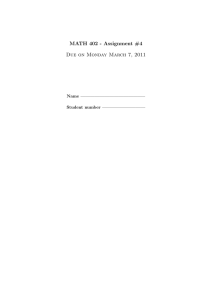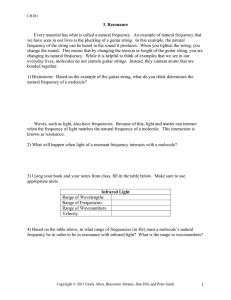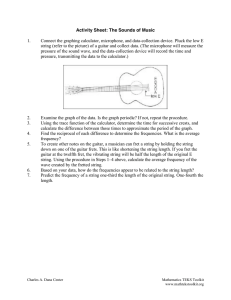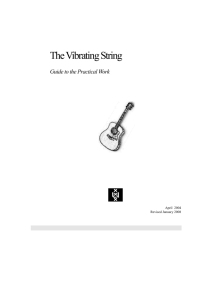Math 2210-1 Homework 3
advertisement
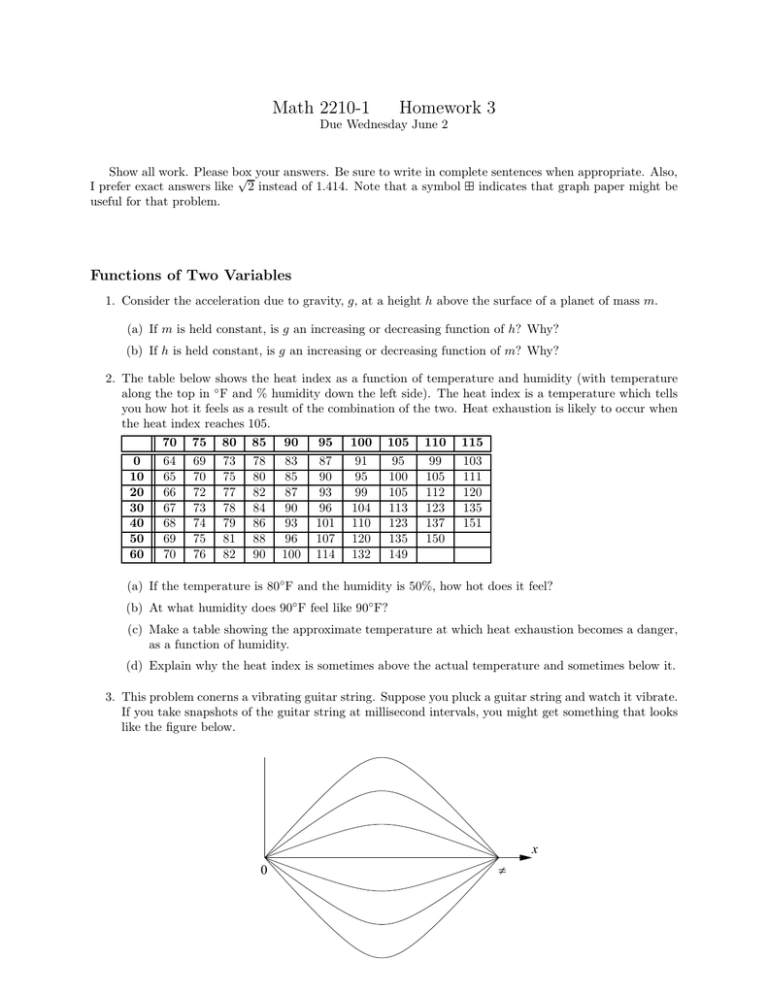
Math 2210-1 Homework 3 Due Wednesday June 2 Show all work. Please box √ your answers. Be sure to write in complete sentences when appropriate. Also, I prefer exact answers like 2 instead of 1.414. Note that a symbol indicates that graph paper might be useful for that problem. Functions of Two Variables 1. Consider the acceleration due to gravity, g, at a height h above the surface of a planet of mass m. (a) If m is held constant, is g an increasing or decreasing function of h? Why? (b) If h is held constant, is g an increasing or decreasing function of m? Why? 2. The table below shows the heat index as a function of temperature and humidity (with temperature along the top in ◦ F and % humidity down the left side). The heat index is a temperature which tells you how hot it feels as a result of the combination of the two. Heat exhaustion is likely to occur when the heat index reaches 105. 0 10 20 30 40 50 60 70 64 65 66 67 68 69 70 75 69 70 72 73 74 75 76 80 73 75 77 78 79 81 82 85 78 80 82 84 86 88 90 90 83 85 87 90 93 96 100 95 87 90 93 96 101 107 114 100 91 95 99 104 110 120 132 105 95 100 105 113 123 135 149 110 99 105 112 123 137 150 115 103 111 120 135 151 (a) If the temperature is 80◦ F and the humidity is 50%, how hot does it feel? (b) At what humidity does 90◦ F feel like 90◦ F? (c) Make a table showing the approximate temperature at which heat exhaustion becomes a danger, as a function of humidity. (d) Explain why the heat index is sometimes above the actual temperature and sometimes below it. 3. This problem conerns a vibrating guitar string. Suppose you pluck a guitar string and watch it vibrate. If you take snapshots of the guitar string at millisecond intervals, you might get something that looks like the figure below. x 0 π We can analyze the motion of the guitar string using a function of two variables. Think of the guitar string stretched tight along the x-axis from x = 0 to x = π. Each point on the string has an x value 0 ≤ x ≤ π. As the string vibrates, each point on the string moves back and forth on either side of the x-axis. The ends of the string at x = 0 and x = π remain stationary, while the point at the middle of the string moves the most. Let f (x, t) be the displacement at time t of the point on the string located x units from the left end. Then a possible formula for f (x, t) is f (x, t) = cos t sin x, 0 ≤ x ≤ π where t is in milliseconds. (a) Sketch graphs of f versus x for fixed t values t = 0, π4 , π2 , 3π 4 , π. Use your graphs to explain why f represents a vibrating guitar string. (b) Explain what the function f (x, 0) and f (x, 1) represent in terms of the vibrating string. (c) Explain what the function f (0, t) and f (1, t) represent in terms of the vibrating string. (d) Compare with the motion of f (x, t) the motions of the guitar strings whose displacements are given by g(x, t) = cos 2t sin x, h(x, t) = cos t sin 2x. Cartesian Coordinates in Three-Space 4. Show that (4,5,3), (1,7,4), and (2,4,6) are vertices of an equilateral triangle. 5. Which of the points A = (23, 92, 48), B = (−60, 0, 0), C = (60, 1, −92) is closest to the yz-plane? Which one lies on the xz-plane? Which one is farthest from the xy-plane? 6. Which two of the three points (1,2,3), (3,2,1), and (1,1,0) are closest to each other? 7. What is the equation of the sphere with center at (5,-2,-8) and radius 4? 8. What is the center and radius of the sphere given by x2 + y 2 + z 2 + 8x − 4y − 22z + 77 = 0? 9. Given the sphere (x − 1)2 + (y + 3)2 + (z − 2)2 = 4, (a) Find the equation of the circles (if any) where the sphere intersects each coordinate plane. (b) Find the points (if any) where the sphere intersects each coordinate axis. 10. Sketch the graphs of the equations (a) x = −3 (b) y = 1 (c) z = 2 and y = 4 (this is one graph) (d) x2 + y 2 = 4 p (e) z = 9 − x2 − y 2 Vectors in Three-Space 11. Find the unit vector with the opposite direction as < 3, −4, 5 >. 12. Find the angle between −4i + 2j + 3k and 2i + j + 5k. 13. Find all the vectors perpendicular to both < 1, −2, −3 > and < −3, 2, 0 >. 14. If u =< e, π, 1 > and v =< 1, 1, 0 >, express u as the sum of a vector m parallel to v and a vector n perpendicular to v. 15. Find the distance between the parallel planes −3x + 2y + z = 9 and 6x − 4y − 2z = 19. The Cross Product 16. If u =< 3, 3, 1 > and v =< −2, −1, 0 >, and w =< −2, −3, −1 > find each of the following: (a) u × v (b) u · (v × w) (c) u × (v + w) (d) u × (v × w) 17. Find k × j 18. Does there exist any vector u such that u × u = u · u? Explain. 19. Find the equation of the plane through (1,1,2), (0,0,1), and (-2,-3,0). 20. Find a × b (a) a = i + k and b = i + j. (b) a = i + j + k and b = i + j − k. (c) a = −i and b = j + k. (d) a = 2i − 3j + k and b = i + 2j − k. 21. Suppose a and b are vectors in the xy-plane such that a = a1 i + a2 j and b = b1 i + b2 j with 0 < a1 < a2 and 0 < b1 < b2 . (a) Sketch a and b and the vector c = −a2 i + a1 j. Shade the parallelogram formed by a and b. (b) What is the relation between a and c? [Hint: Find c · a and c · c]. (c) Find c · b. (d) Explain why c · b gives the area of the parallelogram formed by a and b. (e) Verify that in this case a × b = (a1 b2 − a2 b1 )k. 22. If v and w are nonzero vectors, use the geometric definition of the cross product to explain why (λv) × w = λ(v × w) = v × (λw). Consider the cases λ > 0, λ < 0, and λ = 0 separately.

